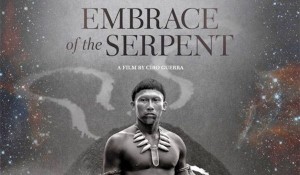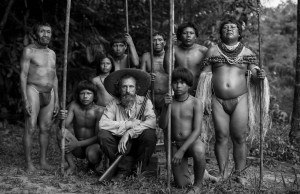Embrace of the Serpent
 One of the films juried into this year’s Bonita Springs International Film Festival is a title named Embrace of the Serpent. It’s so good that it garnered an Oscar nomination for best foreign language film. Although Son of Saul took the golden statue, Embrace of the Serpent is the first Columbian film to ever be nominated for that honor. It’s a really big
One of the films juried into this year’s Bonita Springs International Film Festival is a title named Embrace of the Serpent. It’s so good that it garnered an Oscar nomination for best foreign language film. Although Son of Saul took the golden statue, Embrace of the Serpent is the first Columbian film to ever be nominated for that honor. It’s a really big  deal for Columbians, who had watched the industry disintegrate in the 1980s and 1990s under the yoke of drug violence and guerrilla warfare.
deal for Columbians, who had watched the industry disintegrate in the 1980s and 1990s under the yoke of drug violence and guerrilla warfare.
“This is a very special moment for Colombia that is reflected in this film,” said Colombian Ambassador Juan Carlos Pinzón before a private screening of the film at the Motion Picture Association of America in Washington in 2016. “As you  know, Colombia was having difficult times for a long time. Things have changed in a positive way…. At the same time, things are happening in the movie market.”
know, Colombia was having difficult times for a long time. Things have changed in a positive way…. At the same time, things are happening in the movie market.”
Embrace of the Serpent takes viewers into the Amazon. “In choosing to make his third feature film  out of a story set in the Colombian Amazon, director Ciro Guerra entered a world that Colombians themselves don’t know much about,” writes reviewer David Montgomery for The Washington Post’s Arts & Entertainment Section. But while he started with the diaries of two explorers who paddled and trekked through this secret land
out of a story set in the Colombian Amazon, director Ciro Guerra entered a world that Colombians themselves don’t know much about,” writes reviewer David Montgomery for The Washington Post’s Arts & Entertainment Section. But while he started with the diaries of two explorers who paddled and trekked through this secret land  some 40 years apart in the first half of the 20th Century, Guerra decided to tell his story from the point of view of the indigenous people they encountered instead of the explorers themselves.
some 40 years apart in the first half of the 20th Century, Guerra decided to tell his story from the point of view of the indigenous people they encountered instead of the explorers themselves.
“Guerra and co-writer Jacques Toulemonde created the character of Karamakate, a shaman, the last survivor of his  people, who meets the white explorers loosely based on the real ones during their respective explorations, separated by decades,” Montgomery notes. “The fictional explorers are seeking the same rare and sacred plant that has healing and psychedelic powers. The film braids the two encounters together as the young Karamakate accompanies the European and the old Karamakate
people, who meets the white explorers loosely based on the real ones during their respective explorations, separated by decades,” Montgomery notes. “The fictional explorers are seeking the same rare and sacred plant that has healing and psychedelic powers. The film braids the two encounters together as the young Karamakate accompanies the European and the old Karamakate  travels with the American. In old age, the shaman has forgotten some of his sacred knowledge and memories, and his quest involves recovering his past and seeking a way to pass it on so that it will survive.”
travels with the American. In old age, the shaman has forgotten some of his sacred knowledge and memories, and his quest involves recovering his past and seeking a way to pass it on so that it will survive.”
 And it is this aspect of the film that provides viewers with its greatest degree of poignancy and resonance. Karamakate’s memory and vibrancy have eroded so much that he refers to himself resignedly as a chullachaqui — a ghostlike alter ego that is empty and hallow and merely drifts through the world.
And it is this aspect of the film that provides viewers with its greatest degree of poignancy and resonance. Karamakate’s memory and vibrancy have eroded so much that he refers to himself resignedly as a chullachaqui — a ghostlike alter ego that is empty and hallow and merely drifts through the world.
 “Memory is a central theme in Embrace of the Serpent, as is the struggle for permanence in a world that is constantly threatening to erase one’s identity,” writes Collin Brennan in Consequences of Sound. And Guerra underscores this message by shooting the majority of the film in black-and-white. “There’s an abstracted quality to black-and-white film that makes an image appear more timeless, more authentic somehow,”
“Memory is a central theme in Embrace of the Serpent, as is the struggle for permanence in a world that is constantly threatening to erase one’s identity,” writes Collin Brennan in Consequences of Sound. And Guerra underscores this message by shooting the majority of the film in black-and-white. “There’s an abstracted quality to black-and-white film that makes an image appear more timeless, more authentic somehow,”  Brennan continues. “One might think the filmmaker mad for not taking advantage of the vivid colors of the jungle, but this is not a film about visuals so much as a film about the conflict between letting go of the past and holding onto it for dear life. Rendered without color, the Amazon also appears more alien to us — more entirely unknowable. This is a world that exists fully outside of our own,
Brennan continues. “One might think the filmmaker mad for not taking advantage of the vivid colors of the jungle, but this is not a film about visuals so much as a film about the conflict between letting go of the past and holding onto it for dear life. Rendered without color, the Amazon also appears more alien to us — more entirely unknowable. This is a world that exists fully outside of our own,  without even the most basic of sensory reference points to grasp onto for comfort.”
without even the most basic of sensory reference points to grasp onto for comfort.”
If this were all Embrace of the Serpent had to offer, it would be enough. But the bulk of the film is actually devoted to observing the folklore of individual tribes and  learning about their greater spiritual belief system.
learning about their greater spiritual belief system.
Of course, not every reviewer has raved about the film. “The movie never becomes particularly visionary, much less trippy,” proclaims the exalted one, Roger Ebert. “It’s an earthbound, prosaic story that plays by  most of the usual commercial storytelling rules … [which] is frustrating because in every other way, the movie is original in concept, remarkable in execution, and filled with characters whose motivations and personalities are developed with clarity and humor.”
most of the usual commercial storytelling rules … [which] is frustrating because in every other way, the movie is original in concept, remarkable in execution, and filled with characters whose motivations and personalities are developed with clarity and humor.”
Ebert aside, Embrace of the Serpent is that rare film that has the  power to transform, to shake one’s belief system so thoroughly that one feels like a slightly different person walking out of the theater. “If there’s a better argument for a piece of art than that,” counters The Washington Post’s David Montgomery, “I’d sure like to hear it.”
power to transform, to shake one’s belief system so thoroughly that one feels like a slightly different person walking out of the theater. “If there’s a better argument for a piece of art than that,” counters The Washington Post’s David Montgomery, “I’d sure like to hear it.”
RELATED POSTS.
- BIFF opens with red carpet entry, ‘Our Last Tango,’ and Opening Night Party
- ‘Our Last Tango’ is spellbinding love story set against background of dance
 What the critics have said about ‘Our Last Tango’
What the critics have said about ‘Our Last Tango’- Meet ‘Our Last Tango’ filmmaker German Kral
- Friday’s schedule of BIFF films in the Moe Auditorium & Film Center
- Friday’s schedule of BIFF films in the Hinman Auditorium
- ‘The Stairs’ renders Holocaust more than abstraction for
 generations of viewers
generations of viewers - Focus on ‘Fighting a War of My Own’ filmmaker Aaron Jackson















 Tom Hall is both an amateur artist and aspiring novelist who writes art quest thrillers. He is in the final stages of completing his debut novel titled "Art Detective," a story that fictionalizes the discovery of the fabled billion-dollar Impressionist collection of Parisian art dealer Josse Bernheim-Jeune, thought by many to have perished during World War II when the collection's hiding place, Castle de Rastignac in southern France, was destroyed by the Wehrmacht in reprisal for attacks made by members of the Resistance operating in the area. A former tax attorney, Tom holds a bachelor's degree as well as both a juris doctorate and masters of laws in taxation from the University of Florida. Tom lives in Estero, Florida with his fiancee, Connie, and their four cats.
Tom Hall is both an amateur artist and aspiring novelist who writes art quest thrillers. He is in the final stages of completing his debut novel titled "Art Detective," a story that fictionalizes the discovery of the fabled billion-dollar Impressionist collection of Parisian art dealer Josse Bernheim-Jeune, thought by many to have perished during World War II when the collection's hiding place, Castle de Rastignac in southern France, was destroyed by the Wehrmacht in reprisal for attacks made by members of the Resistance operating in the area. A former tax attorney, Tom holds a bachelor's degree as well as both a juris doctorate and masters of laws in taxation from the University of Florida. Tom lives in Estero, Florida with his fiancee, Connie, and their four cats.